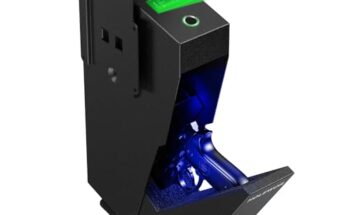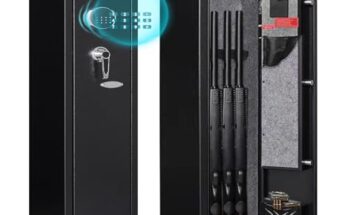Canadian law mandates secure storage for firearms, requiring gun safes to be lockable and bolted to structure. These regulations aim to prevent unauthorized access and enhance safety.
Understanding Canadian gun safe installation laws is crucial for responsible firearm ownership. Properly installed gun safes guard against theft and limit access to individuals who possess the necessary permits and training. Ensuring that gun safes meet the legal specifications not only complies with national safety standards but also promotes a culture of responsible gun handling.
These installations form part of a broader framework of regulations designed to protect citizens and prevent accidents. Gun owners must familiarize themselves with the specifics of the lock, stock, and bolt requirements to adhere to the Canadian Firearms Program’s guidelines.
Canada’s Legal Framework For Gun Safes
Welcome to the overview of Canada’s legal requirements for gun safes. Gun ownership carries significant responsibility. Canadian law reflects this through strict regulations ensuring the safe storage of firearms. Let’s delve into what governs gun safe installation in Canada.
Legislation Governing Firearm Storage
Canadian firearm owners must follow precise legal protocols. These are set out in the Criminal Code of Canada and the Firearms Act. Together these laws specify how to secure firearms.
- The Criminal Code demands secure locking devices.
- The Firearms Act outlines storage, handling, and transportation regulations.
Non-restricted firearms need a secure locking device or a locked container. For restricted and prohibited firearms, owners must disable them and lock them away.
The Importance Of Secure Storage Compliance
Secure storage is not just a legal requirement; it is a safety imperative. Accidental discharge and unauthorized use can lead to tragic consequences. Compliance with storage laws protects owners and the public alike.
By following these guidelines, gun owners minimise risks:
- Preventing access to unauthorized users.
- Protecting against theft or loss.
- Reducing the potential for accidental harm.
Penalties for non-compliance can be severe. They range from fines to imprisonment, varying with the gravity of the offense.
Understanding and complying with Canada’s secure gun storage laws is essential for every gun owner. This practice ensures safety while upholding the law.
Requirements For Gun Safe Installation
Keeping firearms secure is crucial in Canada. The law sets strict rules for gun safe installation. Owners must meet these rules to ensure safety. We will cover the criteria for an approved gun safe. Also, we will detail the positioning and anchoring standards. These standards help prevent unauthorized access to firearms.
Criteria For An Approved Gun Safe
Gun safes in Canada must follow certain criteria to be considered approved by the law. These include:
- Sturdy Construction: The safe must be made of robust materials that resist tampering.
- Secure Lock: Safes require a reliable locking mechanism. Combination locks or key locks are common.
- Size Requirements: The safe must be large enough to store all firearms safely.
The law provides specifications for each criterion. These ensure that all gun safes offer a high level of protection.
Positioning And Anchoring Standards
Correctly positioning and anchoring a gun safe is as important as the safe itself. Standards for positioning and anchoring include:
| Location | Requirements |
|---|---|
| Visibility: | Placement should be discreet to reduce risk of theft. |
| Accessibility: | Safes must be easily accessible to owners, but not to others. |
| Anchor Points: | Safes should be anchored to the structure of the building. |
This table shows key points for positioning a gun safe. Anchoring the safe properly prevents it from being removed. Following these guidelines will align with Canadian law.
Gun Safe Features For Added Security
Guns are a big responsibility. Keeping them safe is not just smart—it’s the law in Canada. Let’s talk about the cool things that make gun safes secure. We want to keep our guns away from bad people or accidents.
Locking Mechanisms Explained
Locks on gun safes are like secret handshakes. Only the right one opens the door. There are different kinds:
- Key locks – Simple and easy. Just turn the key!
- Combination locks – Spin the dial to the right numbers.
- Electronic locks – Key in a code for quick access.
- Biometric locks – They know you by your fingerprint.
A good gun safe has two or more locks. This makes it extra tough for thieves.
Materials And Build: What To Look For
A safe is only good if it’s tough as nails. Check out what makes a safe strong:
- Heavy metal – Thicker metal is harder to break.
- Tight doors – No gaps mean no easy way in.
- Hidden hinges – Out of sight, out of mind, and out of reach.
Experts say, look for steel that’s hard to drill through. A thick door and walls are the best. Make sure your safe says it is for guns. This means it’s designed to keep your guns locked up tight.

Credit: en.wikipedia.org
Inspections And Legal Consequences
In Canada, gun safety is paramount, leading to stringent laws on gun safe installation. Understanding the legal framework is crucial for any firearm owner. Adherence to the law is not a mere formality; it’s a responsibility. This section delves into what to expect during government inspections and the ramifications of non-compliance.
Government Inspections: Preparation Tips
Regular checks ensure compliance with the Canadian Firearms Program. Be ready for an inspection at any time.
- Documentation: Keep all firearm acquisition and registration certificates accessible.
- Storage: Verify guns are stored according to the regulations.
- Accessibility: Limit access to your gun safes to authorized persons only.
Be prepared to demonstrate compliance with all safe installation requirements during the inspection. Your cooperation with the inspectors showcases your commitment to public safety.
Penalties For Non-compliance
Ignorance of the law is no excuse, and violating gun safe installation regulations has serious consequences.
| Violation | Penalty |
|---|---|
| Improper Storage | Fines or imprisonment |
| Lack of Documentation | Legal charges and potential confiscation |
| Unauthorized Access | Severe legal repercussions |
Non-compliance can lead to loss of firearm privileges, tarnish your record, and, worst-case scenario, result in criminal charges. Stay informed and vigilant.
Best Practices For Responsible Gun Owners
Being a responsible gun owner in Canada means adhering to strict laws and regulations. It’s about safeguarding not just your own security, but also that of those around you. The Canadian Law on Gun Safe Installation, Lock Stock, and Bolt sets out clear guidelines to achieve this. Yet, beyond legal requirements, there are best practices that are pivotal to ensuring ongoing safety and peace of mind. Let’s explore two key areas of responsible gun ownership: regular maintenance and upkeep, and the education of household members on safety and protocols.
Regular Maintenance And Upkeep
Consistent care for your firearms and safety equipment can’t be overstated. This diligence prevents malfunctions and ensures readiness. Here are steps to follow:
- Inspect your gun safe regularly for signs of wear and tear.
- Clean firearms after every use, following the manufacturer’s guide.
- Oil moving parts to avoid rust and ensure smooth operation.
- Test locks and bolts frequently to confirm they’re functioning properly.
- Review your gun storage conditions, as humidity and temperature can affect performance.
Educating Household On Safety And Protocol
A safe home is a knowledgeable home. Educate everyone about the potential risks and proper handling. Consider these steps:
- Discuss the importance of gun safety with all family members.
- Demonstrate how to behave around guns, even for non-users.
- Establish clear rules about access to the safe and firearms.
- Conduct regular refreshers on these topics to keep safety top of mind.
/cloudfront-us-east-1.images.arcpublishing.com/dmn/6G3ZB4KIBFACJKO3QAIAAUN4GA.jpg)
Credit: www.dallasnews.com
Additional Measures For Enhanced Safety
In the vast stretch of Canada, safety measures for gun storage magnify peace of mind. When securing firearms, the law mandates not only a solid lock but also additional practices. Beyond the basic requirements, let’s boost security to safeguard against any unforeseen events.
Utilizing Alarm Systems And Surveillance
Keeping a vigilant eye matters most. Integrate alarm systems with your safe’s location. A piercing alert deters intruders. Surveillance cameras act as silent guardians. Together, they form an unbreakable shield. Consider these points for robust protection:
- Link alarms directly to local authorities.
- Opt for motion sensors near the safe.
- Install cameras with night vision capabilities.
- Ensure surveillance feeds are encrypted.
Safe Storage During Transportation
Moving firearms demands caution. Regardless of the distance, transport your guns wisely. Implement these tips for seamless safety:
- Unload all firearms before transportation.
- Use a lockable case; ensure it’s sturdy and immovable.
- Conceal the case to avoid drawing attention.
- Keep ammo separate in a locked container.
Stay alert at all times. Secure guns properly. Ensure they’re inaccessible during transit.

Credit: www.titanfile.com
Frequently Asked Questions On The Canadian Law On Gun Safe Installation Lock Stock And Bolt
Does A Gun Safe Have To Be Bolted To The Wall?
A gun safe does not have to be bolted to the wall, but securing it can prevent theft and improve safety.
Do You Need A Trigger Lock In A Safe Canada?
In Canada, a trigger lock is not mandatory if a firearm is stored in a locked safe. A secure locking device or storage in a safe complies with Canadian firearms storage regulations.
What Are The Laws For Storing Firearms In Canada?
In Canada, store firearms unloaded and locked, with ammunition stored separately. Follow the specific regulations for restricted and non-restricted firearms, ensuring safe handling and compliance with the Canadian Firearms Program.
Do Gun Safes Have To Be Bolted To The Floor?
Gun safes do not legally have to be bolted to the floor, but it’s recommended for added security against theft and tipping.
Conclusion
Understanding Canadian gun safe regulations is essential for responsible firearm ownership. Secure storage prevents unauthorized access and reduces risks considerably. Adhere to the law; prioritize safety with proper gun safe installation. Remember, a lock, stock, and bolt approach embodies both legal compliance and peace of mind for Canadian gun owners.



